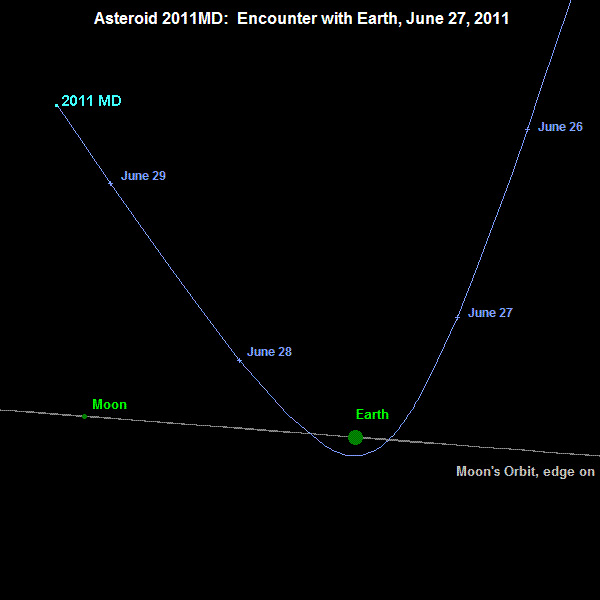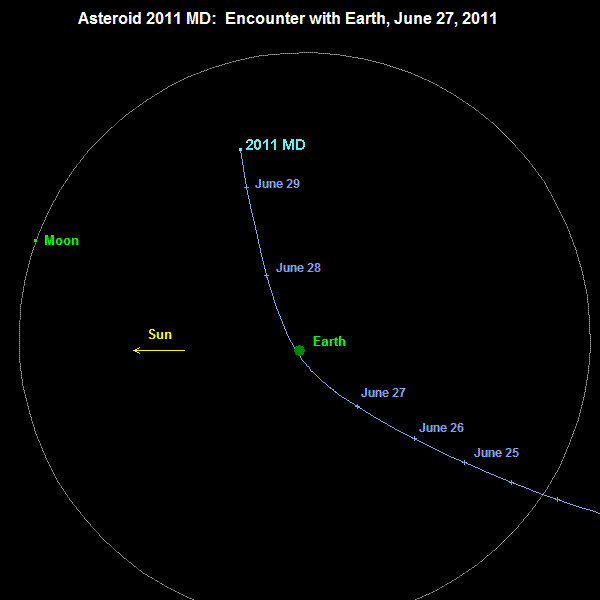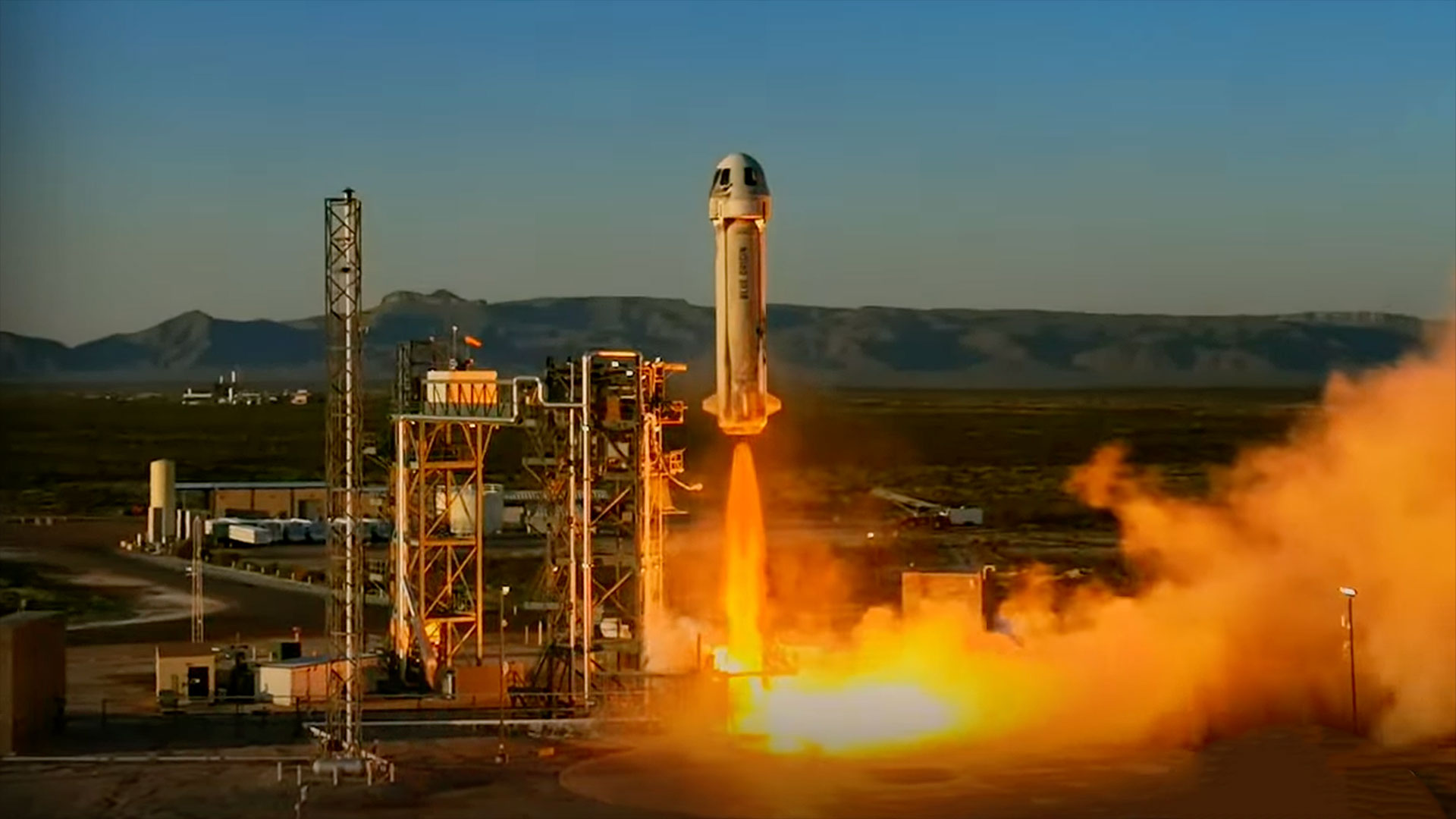Asteroid to Pass Extremely Close By Earth On Monday

UPDATE for 5:35 p.m. ET: NASA has recalculated the time of closest approach for this event to be about 3 1/2 hours later than initially reported. The change is reflected below.
Here's something to dwell on as you head to work next week: A small asteroid the size of a tour bus will make an extremely close pass by the Earth on Monday, but it poses no threat to the planet
The asteroid will make its closest approach at 1:14 p.m. EDT (1714 GMT) on June 27 and will pass just over 7,500 miles (12,000 kilometers) above the Earth's surface, NASA officials say. At that particular moment, the asteroid — which scientists have named 2011 MD — will be sailing high off the coast of Antarctica, almost 2,000 miles (3,218 km) south-southwest of South Africa.
Asteroid 2011 MD was discovered Wednesday (June 22) by LINEAR, a pair of robotic telescopes in New Mexico that scan the skies for near-Earth asteroids. The best estimates suggest that this asteroid is between 29 to 98 feet (9 to 30 meters) wide.
According to NASA's Near-Earth Object Office at the Jet Propulsion Laboratory (JPL) in Pasadena, Calif., an object of this size can be expected to come this close to Earth about every 6 years or so, on average. [Photo of asteroid 2011MD trajectory]
"There is no chance that 2011 MD will hit Earth but scientists will use the close pass as opportunity to study it w/ radar observations," astronomers with NASA's Asteroid Watch program at JPL wrote in a Twitter post Thursday (June 23).
Even if the asteroid were to enter Earth's atmosphere, it likely wouldn't reach the surface, they added.
Breaking space news, the latest updates on rocket launches, skywatching events and more!
"Asteroid 2011 MD measures about 10 meters. Stony asteroids less than 25 m would break up in Earth's atmosphere & not cause ground damage," Asteroid Watch scientists said.
The asteroid's upcoming Earth flyby will be a close shave, but not a record for nearby passing asteroids. The record is currently held by the asteroid 2011 CQ1, which came within 3,400 miles (5,471 kilometers) of Earth on Feb. 4 of this year.
A tricky skywatching target
For several hours prior to its closest approach, 2011 MD will be visible in moderately-large amateur telescopes. But despite its close approach, actually seeing this asteroid will not be an easy task.
"These objects are so small (10 meters) that normally a sizeable telescope is required," Asteroid Watch scientists warned.
You will need to have access to an excellent star atlas, and because it will be moving so rapidly you'll also need the very latest data from the Minor Planet Center to track its precise course against the background stars. The asteroid is not expected to get very bright; about 250 times dimmer than the faintest stars visible to the eye without optical aid. [Photos: Asteroids in Deep Space]
The asteroid will pass so close that Earth's gravity will sharply alter the asteroid's trajectory.
After making its closest pass to Earth, the asteroid will zoom through the zone of geosynchronous satellites. The chance of a collision with a satellite or piece of space junk is exceedingly remote.
History of near-Earth asteroids
On Oct. 28, 1937, German astronomer Karl Reinmuth (1892-1979) accidentally photographed the long trail of a fast moving asteroid. Two nights later, this asteroid passed within 460,000 miles of the Earth. Reinmuth named it Hermes, after the Olympian god of boundaries and travelers.
Since the vast majority of asteroids (so far numbering over 210,000) congregate between the orbits of Mars and Jupiter, astronomers at that time felt that Hermes' very close approach was an outstanding exception.
"Astronomers of the day were somewhat biased," explained NASA asteroid scientist Paul Chodas. "They had convinced themselves that collisions were too rare to consider."
Since then, astronomers have learned that asteroids can make very close approaches to Earth with far greater frequency than previously thought. Asteroid 2011 MD's Monday pass is a prime example of that.
Of the 8,099 Near-Earth objects that have been discovered, about 827 of them are asteroids with a diameter of approximately a half-mile (1 km) or larger. About 1,236 of these NEOs have been classified as Potentially Hazardous Asteroids (PHAs).
NASA currently plans to launch a probe to visit one of these potentially dangerous near-Earth objects and return samples of the asteroid to Earth.
That mission will launch the OSIRIS-Rex asteroid probe in 2016 to rendezvous with the space rock 1999 RQ36 in 2020. The target asteroid is 1,900 feet (580 meters) wide and has a 1-in-1,800 chance of hitting Earth in the year 2170, and a 1-in-1,000 chance of slamming into us in 2182.
Joe Rao serves as an instructor and guest lecturer at New York's Hayden Planetarium. He writes about astronomy for The New York Times and other publications, and he is also an on-camera meteorologist for News 12 Westchester, New York.

Joe Rao is Space.com's skywatching columnist, as well as a veteran meteorologist and eclipse chaser who also serves as an instructor and guest lecturer at New York's Hayden Planetarium. He writes about astronomy for Natural History magazine, Sky & Telescope and other publications. Joe is an 8-time Emmy-nominated meteorologist who served the Putnam Valley region of New York for over 21 years. You can find him on Twitter and YouTube tracking lunar and solar eclipses, meteor showers and more. To find out Joe's latest project, visit him on Twitter.

